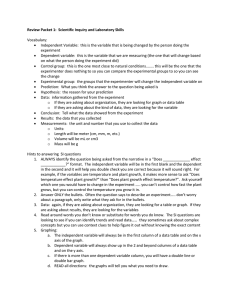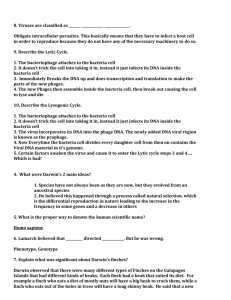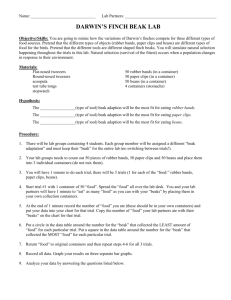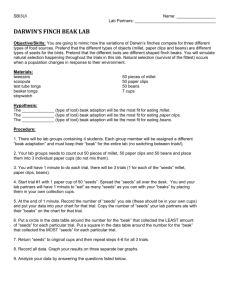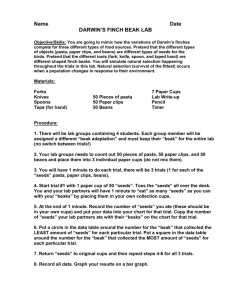Making Connections
advertisement
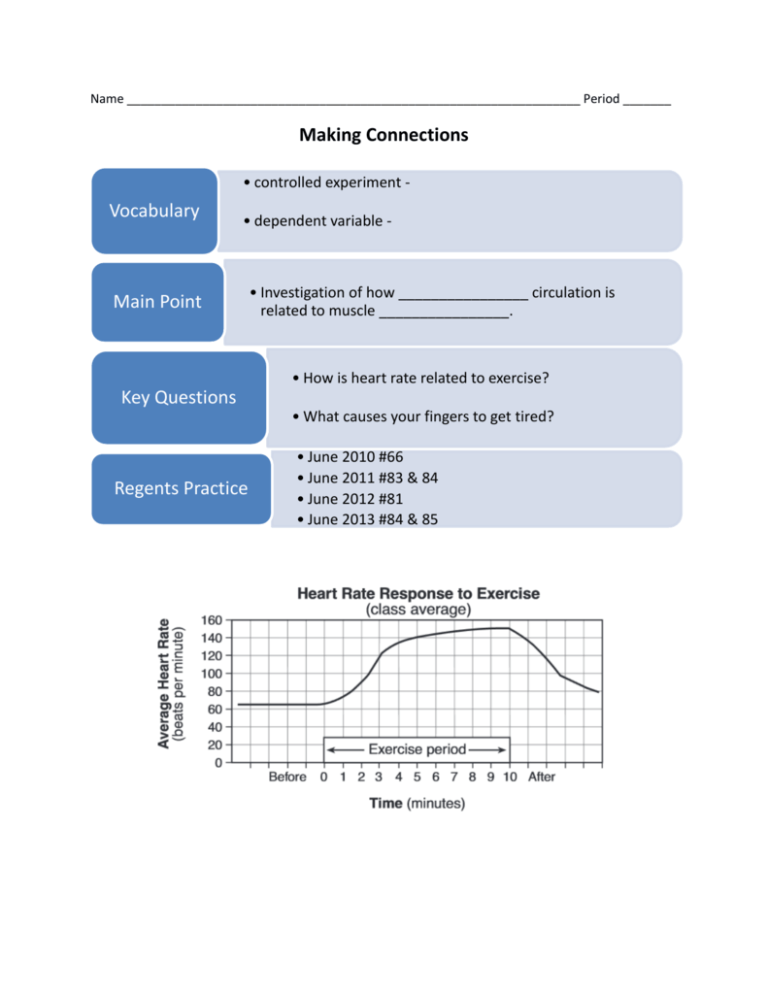
Name __________________________________________________________________ Period _______ Making Connections • controlled experiment - Vocabulary • dependent variable - Main Point • Investigation of how ________________ circulation is related to muscle ________________. • How is heart rate related to exercise? Key Questions • What causes your fingers to get tired? Regents Practice • June 2010 #66 • June 2011 #83 & 84 • June 2012 #81 • June 2013 #84 & 85 Diffusion Through a Membrane • diffusion - Vocabulary • selectively permeable - Main Point Key Questions Regents Practice • This lab investigated two selectively permeable membranes; dialysis tubing and _____________________. • What happens to starch, glucose, iodine? • What is effect of adding salt to cell? • What is this process called? • What is the effect of adding low solute concentration to cell? • June 2010 # 67, 72-74 • June 2011 # 73, 85 • June 2012 # 78-80 • June 2013 # 73-75, 79&80 Relationships and Biodiversity • gel electrophoresis - Vocabulary • restriction enzyme • chromatography - Main Point • To find the __________________between several species of plants using structural and molecular evidence. • Which type of evidence is more reliable when testing a relationship? Key Questions • Provide a biological explanation for the common characteristics these species share. Regents Practice • June 2010 #65, 68-71, 75 • June 2011 #76-82 • June 2012 #73-74, 82-85 • June 2013 # 76-78 BEAKS OF FINCHES • natural selection - Vocabulary • niche • adaptation - Main Point • To demonstrate how ____________________ in beak shape can affect natural selection. • What adaptations caused your beak/bird to be successful? Key Questions • What drives evolution? Regents Practice • June 2010 #76,77 • June 2011 #74-75 • June 2012 #75-77 • June 2013 #81-83 Making Connections answers June 2010 66 [1] Allow 1 credit. Acceptable responses include, but are not limited to: — As she continued to use her hand, her muscles became fatigued. — Wastes built up. — ATP was used up. June 2011 83 [1] Allow 1 credit. Acceptable responses include, but are not limited to: — When the student was sleeping, her activity was minimal and her pulse rate was slow. When she was walking, she used more energy, resulting in an increased pulse rate. — Pulse rate varies with activity level. — Her body was maintaining homeostasis. — Her heart beats faster when she is more active. 84 [1] Allow 1 credit. Acceptable responses include, but are not limited to: — Increased pulse rate increases the availability of food and oxygen to cells. — The pulse rate is an indication of the activity level of the body. Additional food and oxygen is provided to body cells with an increase in pulse rate. — increases the removal of wastes from cells June 2012 81 Multiple Choice 4 June 2013 84 [1] Allow 1 credit. Acceptable responses include, but are not limited to: — oxygen (O2) — carbon dioxide (CO2) — lactic acid — adrenaline 85 [1] Allow 1 credit. Acceptable responses include, but are not limited to: — Results from a larger sample are more reliable than results from a small sample. — Using data from more students makes it more likely that the results will be accurate. — You could compare the results for both boys and girls, which makes the study more valid. Diffusion Through a Membrane June 2010 67 [1] Allow 1 credit for diffusion or passive transport. 72 [1] Allow 1 credit for labeling the locations of the cell wall and the cell membrane and cytoplasm on the diagram. Example of a 1-credit response: 73 [1] Allow 1 credit. Acceptable responses include, but are not limited to: — Place saltwater solution on one side of the coverslip. Then draw the saltwater solution under the coverslip by placing a piece of paper towel on the opposite side. — Place a drop of saltwater solution on one side of a coverslip and a paper towel on the other side. 74 [1] Allow 1 credit for showing that the membrane has pulled away from the cell wall. June 2011 73 Multiple choice 3 85 [1] Allow 1 credit. Acceptable responses include, but are not limited to: — The stoppers would pop out of the heated tubes and possibly injure someone. — The test tubes may explode. June 2012 78 [1] Allow 1 credit for drawing the expected location of the glucose molecules after 20 minutes. 79 [1] Allow 1 credit. Acceptable responses include, but are not limited to: — All of the starch molecules would be in the artificial cell. — The starch would not move out of the cell. — The starch would stay in the cell. 80 [1] Allow 1 credit. Acceptable responses include, but are not limited to: — A stain makes some organelles more visible. — easier to see cell parts June 2013 73 Multiple choice 1 74 Multiple choice 3 75 Multiple choice 2 79 [1] Allow 1 credit for stating both a description of the procedure and an explanation. Acceptable responses include, but are not limited to: — In procedure A, salt water is added to the cell. The reduced water concentration outside results in water leaving the cell and its cytoplasm shrinks away from the cell wall. — Put the cell in salt solution. Water moves out of the cell and the cell contents shrink. 80 [1] Allow 1 credit. Acceptable responses include, but are not limited to: — In procedure B, distilled water is added to the cell. The distilled water goes into the cell and restores the cytoplasm to the normal size. — Process B is to add distilled water to dilute the salt water. Water will move into the cell and fill it back up. — Process B adds a new substance that causes water to reenter the cell. Relationships and Biodiversity June 2010 65 [1] Allow 1 credit for species A and B and for supporting the answer. Acceptable responses include, but are not limited to: — They are most closely related because there is only one difference in the sequence. — They have the most in common. 68 [1] Allow 1 credit. Acceptable responses include, but are not limited to: — According to diagram 3, C should look different from A and B. — The stem cross sections show that A, B, and C have similar stem structure, indicating that they are most likely closely related. Diagram 3 shows that only A and B are closely related. 69 [1] Allow 1 credit. Acceptable responses include, but are not limited to: — A and B have the most bands in common. 70 2 71 [1] Allow 1 credit. Acceptable responses include, but are not limited to: — DNA analysis is more reliable since the more similar the DNA, the closer the relationship. — Organisms can have similar features, but the DNA coding for these features can be very different. — DNA analysis might reveal the actual genetic makeup. 75 1 June 2011 76 MC 2 77 [1] Allow 1 credit for A. 78 [1] Allow 1 credit for species C or D or E and for supporting the answer. Acceptable responses include, but are not limited to: — Species C, because it became extinct. — D, because it is no longer alive. — Species E does not continue to the present. 79 [1] Allow 1 credit. Acceptable responses include, but are not limited to: — enzymes — restriction enzymes — biological catalyst 80 [1] Allow 1 credit for W and Z and for supporting the answer. — because 4 of the 5 bands are identical — They have the greatest number of matching bands. 81 MC 3 82 MC 1 June 2012 73 MC 2 74 MC 1 82 MC 2 83 [1] Allow 1 credit for the correct amino acid sequences for species A. 85 [1] Allow 1 credit for A and supporting the answer. Acceptable responses include, but are not limited to: — It is most closely related to the endangered species because their amino acid sequences are identical. — It is most closely related to the endangered species because the DNA sequences are the most similar. Note: Allow credit for a response that is consistent with the student’s response to question 83. June 2013 76 MC 1 77 [1] Allow 1 credit for completing the chart as shown below. DNA base sequence: AAC GCC GTC CGC TAG mRNA codons: UUG CGG CAG GCG AUG 78 [1] Allow 1 credit for 4. Beaks of Finches June 2010 76 2 77 2 June 2011 74 2 75 3 June 2012 75 1 76 1 77 [1] Allow 1 credit for small tree finch and supporting the answer. Acceptable responses include, but are not limited to: — The small tree finch eats animals, whereas the other two birds are plant eaters. — It is the only one that eats mainly animal food. — The small tree finch eats animals. — Since the other two species eat plant food, not animal food, a decreased insect population will not affect them. June 2013 81 3 82 4 83 [1] Allow 1 credit for indicating if both species could survive and supporting the answer. Acceptable responses include, but are not limited to: — Yes, but only if there is food that the Akialoa can eat, since it has a very different beak. — No, because the environment might not contain the type of food the Akialoa can eat. — Yes, because they won’t compete for food. — Yes, if they have different niches. — No, it is not the habitat that the Akialoa are adapted to. — Yes, because based on beak shape, they eat different foods.






